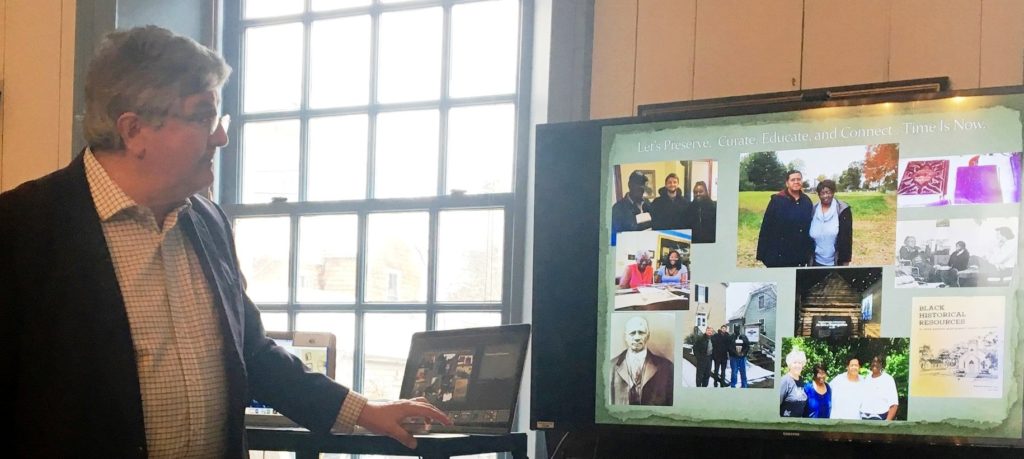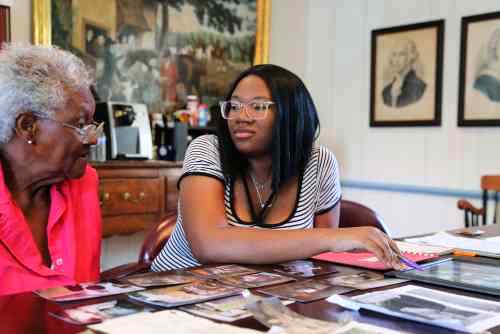Preserve the Past, Educate for the Future: The Chesapeake Heartland Project
Washington College, Starr Center, Chestertown, MD – February 2019
I spent two splendid days at Washington College, Chestertown, MD, for a Chesapeake Heartland Round Table as a representative of the National Museum of African American History and Culture (NMAAHC) per my contract with the museum. It was great to be back teaching again and to see the group engaged in both cognitive and proximate learning. Well organized by Profs. Pat Nugent and Adam Goodheart of Washington College, and joined by Jane Cox, Paris Young, and Jada Aristilde — and by Skype, my friend Tony Cohen. My friends from Montgomery County, Gwen Reese and Suzanne Johnson, couldn’t come due to snow and ice.
For years I’ve wanted to see this kind of group assembled: academic historians, historic preservationists, museum professionals, community members, and students, all focused on a place and looking at it and learning about it from differing points of view. We were “asking big questions of small places” — and in the process, connecting town and gown, past and future, and enhancing the life of individuals and of communities. An excellent model to be used elsewhere by NMAAHC and the college.
Behind the scenes at the Chesapeake Heartland Project Planning Meeting:








Read more about Paris Young ’21, and her internship with the Chesapeake Heartland Project in this excerpt from the Washington College website:
“As an intern at the National Museum of African American History and Culture, Paris Young ’21 is helping develop an innovative project that will digitize and preserve African American history.
“…Young’s work is also laying the groundwork for a major Starr Center initiative. During two visits to Chestertown, Lonnie Bunch, founding director of the NMAAHC, the new Smithsonian museum, began working with the center and local leaders to develop what has been dubbed the Chesapeake Heartland Project, a digital archive that will preserve and share Kent County’s African American history…”
Pictured with Paris is a community member, 80-year-old Irene Moore of Georgetown, who shared photos and newspaper clippings. Many of them documented a racially segregated one-room schoolhouse in Worton Point, built in 1890, that she attended from kindergarten through fifth grade.
 George W. McDaniel, Ph.D., is President of McDaniel Consulting, LLC, a strategy firm that helps organizations use history to build bridges within itself and to its broader constituents. The company’s tag line, “Building Bridges through History,” is grounded in McDaniel’s personal beliefs and his experience in site management, preservation, education, board development, fundraising, and community outreach. Rather than using history to divide us, he strives to help organizations use history, especially local history, to enhance cross-cultural understanding and to support local museums, preservation, and education. Dr. McDaniel recently led volunteer efforts with Emanuel AME Church and historical organizations in Charleston to use historic preservation to enhance racial reconciliation and healing. McDaniel is also the Executive Director Emeritus of Drayton Hall, a historic site in Charleston, SC, owned by the National Trust for Historic Preservation.
George W. McDaniel, Ph.D., is President of McDaniel Consulting, LLC, a strategy firm that helps organizations use history to build bridges within itself and to its broader constituents. The company’s tag line, “Building Bridges through History,” is grounded in McDaniel’s personal beliefs and his experience in site management, preservation, education, board development, fundraising, and community outreach. Rather than using history to divide us, he strives to help organizations use history, especially local history, to enhance cross-cultural understanding and to support local museums, preservation, and education. Dr. McDaniel recently led volunteer efforts with Emanuel AME Church and historical organizations in Charleston to use historic preservation to enhance racial reconciliation and healing. McDaniel is also the Executive Director Emeritus of Drayton Hall, a historic site in Charleston, SC, owned by the National Trust for Historic Preservation.
A frequent writer, speaker, and facilitator about such issues, he can be reached at gmcdaniel4444@gmail.com or through his website at www.mcdanielconsulting.net.
Header Image: Representing the National Museum of African American History and Culture, George W. McDaniel instructs the diverse group of participants, including academic historians, historic preservationists, museum professionals, community members, and students, in looking at a place and learning about it from differing points of view.




 McDaniel Consulting LLC is a strategy firm that helps organizations use history to build bridges within itself and its broader constituents.
McDaniel Consulting LLC is a strategy firm that helps organizations use history to build bridges within itself and its broader constituents.